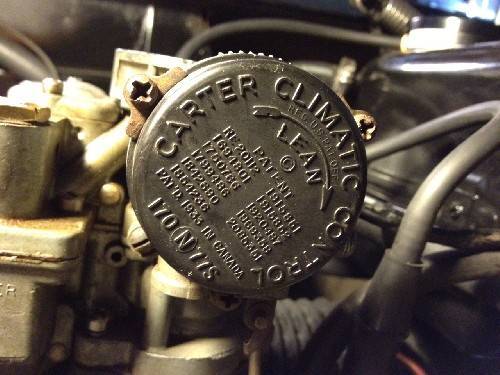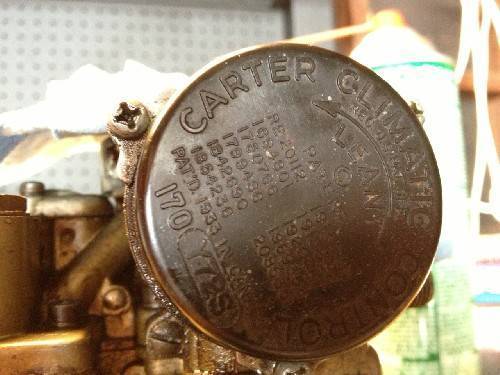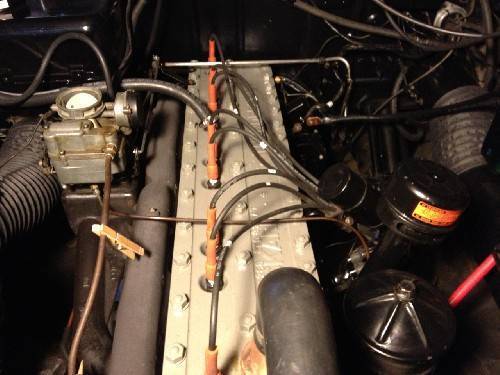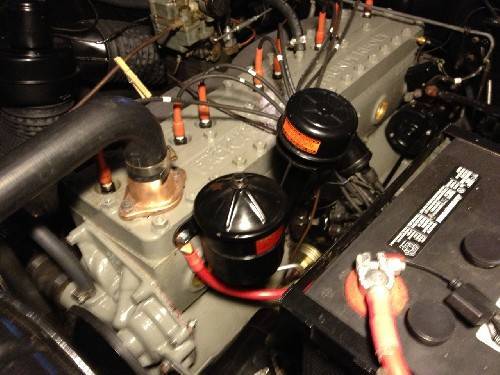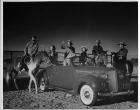|
Re: Miss at Idle
|
||||
|---|---|---|---|---|
|
Just can't stay away
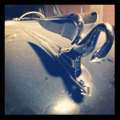
|
Gator,
That's a great suggestion, sir. Now to get a pair of insulated spark plug pullers! To answer your questions, this engine has 40,447 miles on it from new. The first 30,000 miles occurred between 1952 and 1958, and I'm not sure how long it sat between being driven, but it gets driven 100-200 miles a week at highway speeds when it's cooperating now. In Park, the miss is obvious at the tailpipe, and it's steady. I would definitely say it decreases as RPMs increase -- at 1,000 RPM or so, it's gone.
Posted on: 2013/3/5 21:45
|
|||
|
||||
|
Re: Engine weight
|
||||
|---|---|---|---|---|
|
Just can't stay away

|
The short answer? Engine and Transmission: Approx. 1,000 lbs.
The long answer: Weight with Clutch and Transmission (Manual): 860 - 915 lbs. Weight with Overdrive: 895 - 950 lbs. Weight with Transmission (Ultra.): 995 - 1050 lbs. If you figure the cast-iron Ultramatic weighs 275 lbs. dry (per Ultramatic Dynamics), then you're looking at a motor weight of around 745 lbs for a 5-main 327.
Posted on: 2013/3/5 21:26
|
|||
|
||||
|
Re: Difference between WGD-767S and WGD-928S
|
||||
|---|---|---|---|---|
|
Just can't stay away

|
The carburetor casting numbers are the same for the 767 and 928 (as well as the 784) -- they are all #803. As far as I can tell, they differ in the sizes of metering rods and jets, and some of the adjustments are different specs.
Posted on: 2013/3/5 16:48
|
|||
|
||||
|
Re: Miss at Idle
|
||||
|---|---|---|---|---|
|
Just can't stay away

|
Yes, I should have mentioned I did a full tune-up (minus cleaning the fuel bowl since the fuel pump was just replaced a year ago).
In addition to what I mentioned already, I: -Set idle at 375 rpm in high with the parking brake set, per specs -Tightened manifold bolts to 27 ft. lbs. -Tightened carburetor flange -Adjusted idle using a vacuum gauge to obtain smooth idle - the highest and smoothest it gets registers 16 in. Hg. on the vacuum gauge. And sometimes it's very smooth -Re-torqued cylinder head bolts (I did this two months ago right before I painted the block) Things I haven't done because I don't have the proper tools, don't know how to do them safely, or have wanted to eliminate other things first: -Cylinder balance test -Exhaust gas analysis -Remove valve cover and inspect valve springs (no reason to suspect broken springs given that I would have trouble at higher RPM as well) -Rebuild carburetor (I have a spare I want to test but it needs to be rebuilt first, i.e., I don't want to rebuild the one that I'm using now since I know it to be functional -- I'd rather have a known functional and a fresh rebuild to test with in case I bungle the rebuild).
Posted on: 2013/3/5 16:44
|
|||
|
||||
|
Re: Miss at Idle
|
||||
|---|---|---|---|---|
|
Just can't stay away

|
I've been thinking it could be something to do with the cables, is there a way to test for that (other than by getting new cables)?
Posted on: 2013/3/5 15:39
|
|||
|
||||
|
Difference between WGD-767S and WGD-928S
|
||||
|---|---|---|---|---|
|
Just can't stay away

|
I have a spare carburetor that's missing the ID tag, and I'm trying to establish which carburetor it is. The factory carburetor for my 1952 Patrician is a WGD-928S, which is still with the car, ID tag and all, but I wanted to rebuild a spare I have to check and see whether the miss I'm experiencing is a result of faulty carburetion. When I bought the spare, it was supposedly from a '52 Patrician as well, so it should be the same, but as I was comparing the spare to the factory carb, I noticed that the choke adjustment on the spare is opposite of what it is on the factory carb.
Does anyone have a WGD-767 or even a 784 they could let me know which way the lean adjustment is on the Choke adjustment? Are there any other visual cues which could help me identify it? The casting numbers are the same for all three (767, 784, and 928S)... Thanks!
Posted on: 2013/3/5 15:36
|
|||
|
||||
|
Re: Grey engine paint from Bill Hirsch...
|
||||
|---|---|---|---|---|
|
Just can't stay away

|
I'll echo BigKev on this -- prime non-cast iron pieces, but there's no need to prime the cast-iron block and head. Cleanliness and prep are key, I used a ton of heavy duty degreaser, fourteen wire brushes, and two months of patience. The guys at the Hazardous Waste Disposal site knew me by name (you have to collect the rinse water from using degreaser).
The Bill Hirsch paint went right on the cast iron block without issue. It needs 2-3 weeks to cure, and I gave it a week between coats (2 coats cover perfectly).
Posted on: 2013/3/5 15:17
|
|||
|
||||
|
Miss at Idle
|
||||
|---|---|---|---|---|
|
Just can't stay away

|
I've got a '52 Patrician, and I've spent the last several months trying to chase down a slight miss at idle and have come up several possible causes, but have now rectified them and still am experiencing the issue. It's minor, and it doesn't miss noticeably under acceleration or at higher engine speeds, but you can still sense it at moderate engine speeds if you pay very close attention.
Here's what I've checked/changed: -Spark plugs (Tried 2 sets, one gap'd at .025, the other at .028, the larger gap seems to idle better) -Replaced points, condenser, cap, and rotor -Distributor checked (Tested good on a Sun distributor test machine, set points on machine to exact specs) -Checked for vacuum leaks (very small one at #1 cylinder intake manifold connection, tightened manifold bolts) -Replaced vacuum advance (diaphragm was leaking) -Compression: 125 - 127 psi on all cylinders -Timing: Checked 15 times, always dead-on at 6? btdc -Vacuum Test: 16 psi (I suspect a leak, but from where? I've tested vacuum at the manifold port with the power brake booster disconnected, at the fuel pump on both sides, and it's the same low number everywhere. Ran acetylene everywhere and only found a very small leak at the #1 cylinder as noted above. Could it be the carburetor? I'm reticent to pull it off and rebuild it since it has no other symptoms of issues (the car starts immediately hot or cold, there are no flat spots on acceleration, etc.)
Posted on: 2013/3/5 15:10
|
|||
|
||||
|
Re: Grey engine paint from Bill Hirsch...
|
||||
|---|---|---|---|---|
|
Just can't stay away

|
Mark,
The products from Bill Hirsch are excellent. Even when applied with a brush, they look great, stand up well to oil and gas, and last for years in punishingly hot underhood conditions. I went back and forth but after looking at the engines of the Packards at the Automobile Driving Museum and talking with Earl Rubenstein at the Earle C. Anthony region of the Packard Club, I bought the paint from Bill Hirsch. I painted my block myself, with a brush, while the engine was still in the car, and I'm very pleased with the results. So far, I've spilled coolant, sprayed and then baked engine oil on it at speed (leaky oil filter line), and doused it with gasoline while taking the fuel line off the carburetor, and it still looks factory fresh after cleaning up. Have you spoken to the folks at Bill Hirsch over the phone? The guy I got was very happy to talk through the process with me and explained the difference between their engine enamel and other options.
Posted on: 2013/3/5 13:25
|
|||
|
||||


 (112.64 KB)
(112.64 KB)